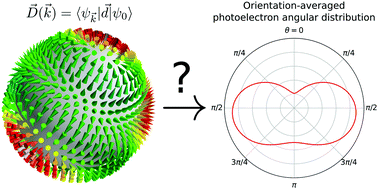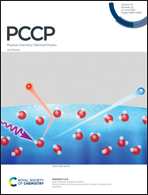A geometric approach to decoding molecular structure and dynamics from photoionization of isotropic samples†
Abstract
We propose a geometric approach to the description and analysis of photoelectron angular distributions resulting from isotropic samples in the case of few-photon ionization by electric fields of arbitrary polarization. This approach formulates the standard photoionization observables – the bl,m expansion coefficients of the photoelectron angular distribution, in terms of geometrical properties of the vector field ![[D with combining right harpoon above (vector)]](https://www.rsc.org/images/entities/i_char_0044_20d1.gif) (
(![[k with combining right harpoon above (vector)]](https://www.rsc.org/images/entities/i_char_006b_20d1.gif) ) ≡ 〈
) ≡ 〈![[k with combining right harpoon above (vector)]](https://www.rsc.org/images/entities/i_char_006b_20d1.gif) |
|![[d with combining right harpoon above (vector)]](https://www.rsc.org/images/entities/i_char_0064_20d1.gif) |0〉 describing the electronic transition from a bound state |0〉 into a scattering state |
|0〉 describing the electronic transition from a bound state |0〉 into a scattering state |![[k with combining right harpoon above (vector)]](https://www.rsc.org/images/entities/i_char_006b_20d1.gif) 〉 – the photoionization transition dipole. Besides revealing selection rules for the enantio-sensitivity of bl,m coefficients in multiphoton ionization, our approach yields very compact expressions for both chiral and achiral molecules revealing how the molecular rotational invariants couple to the rotational invariants of the setup defined by the electric field polarization and the arrangement of photoelectron detectors. We apply this approach to one-photon ionization and find that the forward–backward asymmetry parameter b1,0, emerging exclusively in chiral molecules and encoded in the field
〉 – the photoionization transition dipole. Besides revealing selection rules for the enantio-sensitivity of bl,m coefficients in multiphoton ionization, our approach yields very compact expressions for both chiral and achiral molecules revealing how the molecular rotational invariants couple to the rotational invariants of the setup defined by the electric field polarization and the arrangement of photoelectron detectors. We apply this approach to one-photon ionization and find that the forward–backward asymmetry parameter b1,0, emerging exclusively in chiral molecules and encoded in the field ![[B with combining right harpoon above (vector)]](https://www.rsc.org/images/entities/i_char_0042_20d1.gif) (
(![[k with combining right harpoon above (vector)]](https://www.rsc.org/images/entities/i_char_006b_20d1.gif) ) ≡ i
) ≡ i![[D with combining right harpoon above (vector)]](https://www.rsc.org/images/entities/char_0044_20d1.gif) *(
*(![[k with combining right harpoon above (vector)]](https://www.rsc.org/images/entities/i_char_006b_20d1.gif) ) ×
) × ![[D with combining right harpoon above (vector)]](https://www.rsc.org/images/entities/i_char_0044_20d1.gif) (
(![[k with combining right harpoon above (vector)]](https://www.rsc.org/images/entities/i_char_006b_20d1.gif) ), is sensitive only to the components of
), is sensitive only to the components of ![[D with combining right harpoon above (vector)]](https://www.rsc.org/images/entities/i_char_0044_20d1.gif) (
(![[k with combining right harpoon above (vector)]](https://www.rsc.org/images/entities/i_char_006b_20d1.gif) ) perpendicular to
) perpendicular to ![[k with combining right harpoon above (vector)]](https://www.rsc.org/images/entities/i_char_006b_20d1.gif) , while the regular asymmetry parameter b2,0 emerging in chiral and achiral molecules is sensitive only to the component of
, while the regular asymmetry parameter b2,0 emerging in chiral and achiral molecules is sensitive only to the component of ![[D with combining right harpoon above (vector)]](https://www.rsc.org/images/entities/i_char_0044_20d1.gif) (
(![[k with combining right harpoon above (vector)]](https://www.rsc.org/images/entities/i_char_006b_20d1.gif) ) parallel to
) parallel to ![[k with combining right harpoon above (vector)]](https://www.rsc.org/images/entities/i_char_006b_20d1.gif) . Next, we analyze resonantly enhanced two-photon ionization and show that b0,0 and b1,0 can be written in terms of an effectively stretched
. Next, we analyze resonantly enhanced two-photon ionization and show that b0,0 and b1,0 can be written in terms of an effectively stretched ![[D with combining right harpoon above (vector)]](https://www.rsc.org/images/entities/i_char_0044_20d1.gif) (
(![[k with combining right harpoon above (vector)]](https://www.rsc.org/images/entities/i_char_006b_20d1.gif) ), and how b1,0 and b3,0 can be used to probe
), and how b1,0 and b3,0 can be used to probe ![[B with combining right harpoon above (vector)]](https://www.rsc.org/images/entities/i_char_0042_20d1.gif) (
(![[k with combining right harpoon above (vector)]](https://www.rsc.org/images/entities/i_char_006b_20d1.gif) ).
).

- This article is part of the themed collection: Festschrift Ivan Powis: Advances in Molecular Photoelectron Spectroscopy: Fundamentals & Application


 Please wait while we load your content...
Please wait while we load your content...